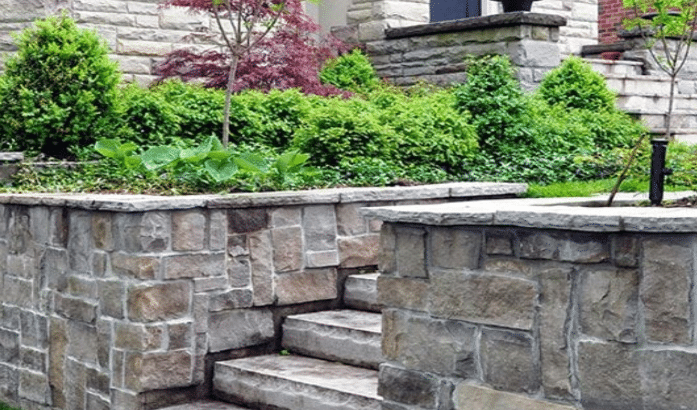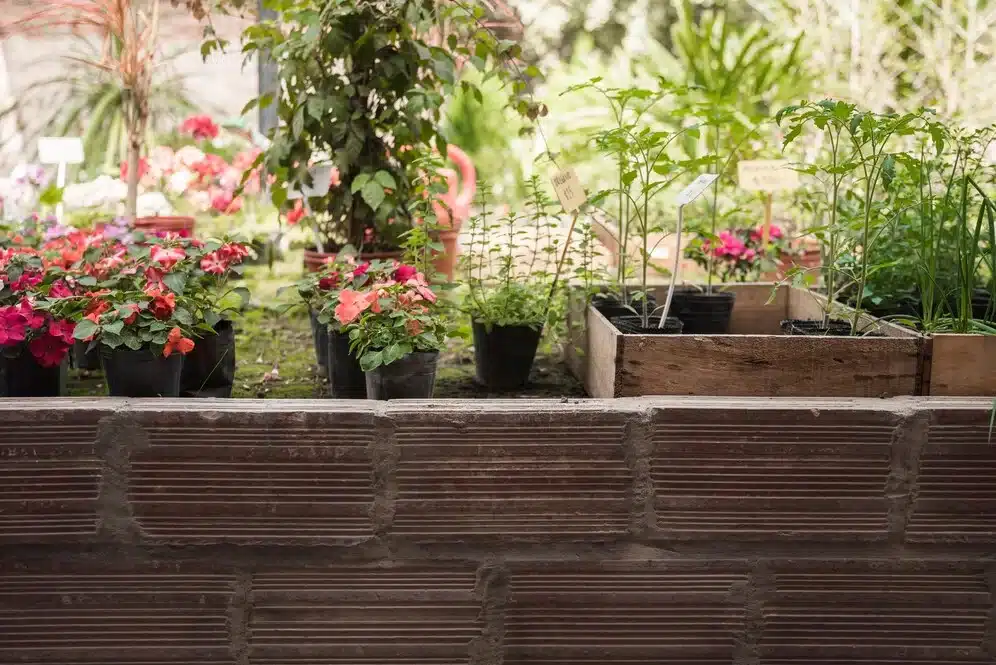Retaining walls are vital building components for building and landscaping. By keeping the ground in place and assisting water to pass through and beyond buildings, they stop soil erosion. This serves as a natural barrier and helps in controlling water buildup.
These walls are constructed from many materials, including treated wood, stones, boulders, and blocks of concrete or stamped concrete. All of the materials are useful for holding debris in place, though some might not be as long-lasting as others.
The purpose of retaining walls is to prevent sideways shifting soil pressure. When the ground rises or falls more than the normal angle of repose of the soil, it becomes extremely important.
Types of retaining walls
1. Gravity Retaining Walls
Gravity retaining walls are designed to resist the pressure of the soil behind them using their weight. Among the most basic and historic kinds of retaining walls are those composed of building materials, masonry made of stone, brick, or blocks.
These walls work by using gravitational force to stay stable, preventing toppling and sliding. They are built with a wider base and sloped faces to handle the higher lateral pressures at greater depths. This design makes them effective for retaining heights up to about 3 meters.
2. Cantilever Retaining Walls
Cantilever retaining walls are built using reinforced concrete. They have an L-shaped or inverted T-shaped foundation. The vertical stress behind the wall is transferred to the foundation, preventing toppling from the soil’s lateral pressure.
For extra stability, the T-shaped base uses the weight of the soil in the front of the wall. An internal ‘key’ can be utilized in the foundation to stop it from falling. These walls are suitable for heights up to 6 meters.
Cantilever walls consist of three parts: the stem, the heel slab, and the toe slab. These components act as cantilevers. The stability of the wall depends on its weight and the weight of the soil on the heel slab.
3. Counterfort Retaining Walls
Similar to cantilever walls, but designed for greater heights, are counterfort retaining walls. They have additional support structures called counterforts. These counterforts are vertical slabs placed behind the wall at 3-meter intervals.
The heel slab and vertical slab act as continuous slabs supported by these counterforts. This design reduces bending moments and shear forces. These walls can be built without a toe if more front clearance is needed, as long as stability against sliding and overturning is maintained. The height of Counterfort retaining walls may range from eight to twelve meters. They offer enhanced stability for tall structures, making them suitable for retaining large amounts of soil.
4. Anchored Retaining Walls
Anchored retaining walls are used in areas with limited space where a thin wall is needed. They are ideal for retaining loose soil over rocks and can be built to great heights. This wall type uses deep wires or cable rods, known as anchors or tiebacks, driven horizontally into the earth.
The ends of these anchors are filled with concrete to provide the necessary anchoring. These anchors counteract sliding pressure and prevent the wall from overturning. They generate resisting forces to oppose the soil pressure, ensuring stability.
Anchored retaining walls offer a stable solution for retaining loose soil in tight spaces. They use deep anchors to counteract pressure and prevent sliding and overturning, making them suitable for tall structures.
5. Sheet Pile Retaining Walls
Steel sheets are used to create a wall in sheet pile retaining walls instead of cement. These walls are made by driving interconnected piles into the foundation soil. Sheet pile walls, which can be temporary or permanent, are used to maintain lateral tension. They provide excellent elasticity and can be used in deep digs without harming nearby structures. The walls are stabilized by the earth’s pressure at the bottom.
These walls work on the same principle as concrete pile walls but are more economical for heights up to 20 feet. They are ideal for areas where deep retention is needed, but the pressure is not as high as that which concrete pile walls can withstand.

Use of Retaining Walls
Retaining walls are flexible constructions that improve a landscape’s appearance and structural soundness. They have many uses and are beneficial from an aesthetic and practical viewpoint.
Creating Terraced Garden Beds
Retaining walls transform uneven or sloped landscapes into multi-level terraced garden beds. These barriers reduce soil erosion and help in soil retention. Terraced garden beds create flat, usable spaces for planting. They add depth and texture to the landscape, allowing for creative gardening. They allow for imaginative gardening and give the landscape depth and traits.
Supporting Raised Patios or Decks
Retaining walls provide stability for outdoor living spaces like patios or decks on sloped terrain. By holding back the soil, they create level surfaces. This maximizes usable space and ensures the safety and longevity of the structure.
Removing Debris from Rough Slopes
On steep slopes, retaining walls work mainly to prevent erosion. They retain the soil, preventing drainage or rain from draining it away. Retaining walls preserve the stability and overall health of the surroundings by stabilizing the soil.
Building Decorative Boundaries
Retaining walls can serve as decorative boundaries around a property. They add an aesthetic touch while defining property lines. To fit the style of the home, these walls can be made with a selection of materials, shapes, and colors. A well-planned retaining wall gives an elegant look and improves street appeal.
Retaining onto Soil
Retaining walls are mostly used to keep soil in place, as their name suggests. This is a vital attribute for homes that are close to waterways or in high-rainfall areas.
Providing Drainage
Retaining walls are also designed to channel water properly and drain it away from the soil. This helps prevent water buildup and reduces erosion. Sufficient drainage protects the reliability and effectiveness of the retaining wall.
Conclusion
It is necessary to have retaining walls for both functional and beautiful reasons. They prevent erosion, support structures, and manage water. With various types and materials, they can suit any need or style. Modern trends are making them more functional and sustainable, enhancing their value in landscaping and construction.

